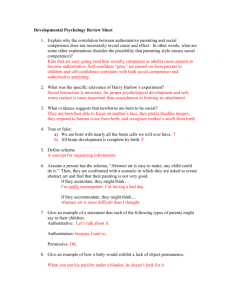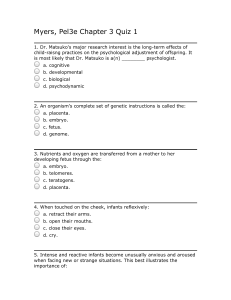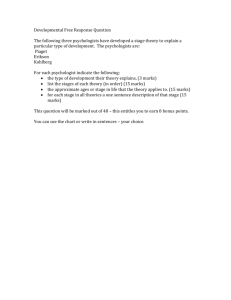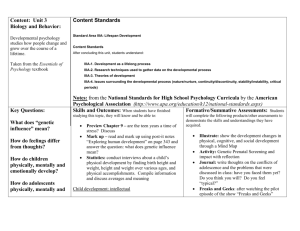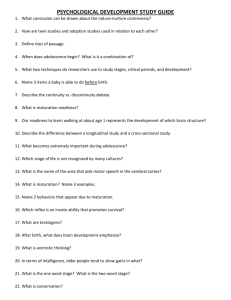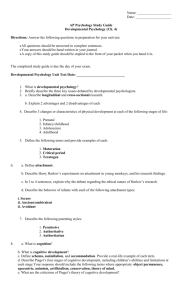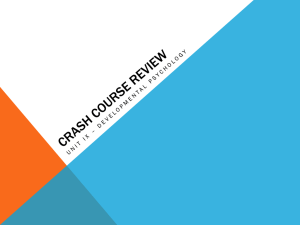test
advertisement
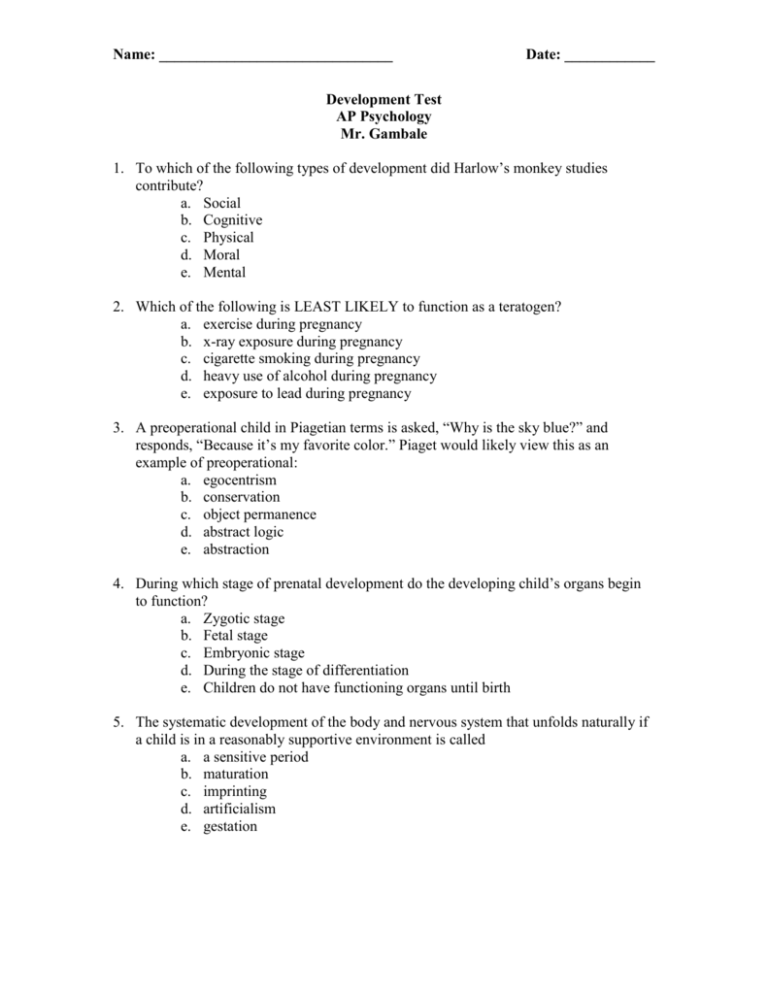
Name: _______________________________ Date: ____________ Development Test AP Psychology Mr. Gambale 1. To which of the following types of development did Harlow’s monkey studies contribute? a. Social b. Cognitive c. Physical d. Moral e. Mental 2. Which of the following is LEAST LIKELY to function as a teratogen? a. exercise during pregnancy b. x-ray exposure during pregnancy c. cigarette smoking during pregnancy d. heavy use of alcohol during pregnancy e. exposure to lead during pregnancy 3. A preoperational child in Piagetian terms is asked, “Why is the sky blue?” and responds, “Because it’s my favorite color.” Piaget would likely view this as an example of preoperational: a. egocentrism b. conservation c. object permanence d. abstract logic e. abstraction 4. During which stage of prenatal development do the developing child’s organs begin to function? a. Zygotic stage b. Fetal stage c. Embryonic stage d. During the stage of differentiation e. Children do not have functioning organs until birth 5. The systematic development of the body and nervous system that unfolds naturally if a child is in a reasonably supportive environment is called a. a sensitive period b. maturation c. imprinting d. artificialism e. gestation 6. Abstract thought : intimacy : : a. Piaget : Freud b. Freud : Piaget c. Kohlberg : Erikson d. Erikson : Kohlberg e. Piaget : Erikson 7. According to David Elkind and other developmental psychologists, the personal fable, the imaginary audience and egocentrism are most closely linked to which of the following age groups? a. children two years of age and younger b. children two to six years of age c. preadolescent children d. adolescents e. the middle aged 8. When stimulated on one side of the mouth, a healthy human newborn will automatically turn its head in that direction, searching with its mouth for a food source. This is called a. the Babinski reflex b. the rooting reflex c. the Moro reflex d. imprinting e. conservation 9. According to Erik Erikson’s fourth stage in his theory of development over the lifespan, if a 7-year-old’s efforts to learn arithmetic are frequently unsuccessful and criticized, the result for the child might be a lifelong sense of a. mistrust b. role confusion c. stagnation d. guilt e. inferiority 10. A five-year-old child reports that the two rows in the following array have the same number of coins: The five-year-old is then shown the array below and reports that the bottom row has more coins. The above is an attempt to measure mastery of a. object permanence b. continuity c. conservation d. animism e. accommodation 11. Lawrence Kohlberg used the fictional Heinz Dilemma to assess the development of moral reasoning in children. One child is asked, “Would you steal a drug in order to save a life?” and the child responds “No, because stealing is against the law.” At which point would Kohlberg likely place such an answer in his theoretical framework? a. level 1: preconventional b. level 2: conventional c. level 3: postconventional d. level 4: formal operational e. level 5: abstract 12. Cross culturally, infants begin to smile at about the same age, even if born blind. This would serve as evidence in support of the ______ in human development. a. role of nature b. role of nurture c. socialization d. assimilation e. habituation 13. Object permanence and conservation, two developmental landmarks are typically mastered in which two of Jean Piaget’s stages of cognitive development, respectively? a. formal operational; concrete operational b. concrete operational, formal operational c. concrete operational; sensorimotor d. sensorimotor; preoperational e. preoperational, formal operational 14. Mary Ainsworth used a “strange situation” scenario to examine ______ in young children. a. IQ b. moral growth c. accommodation d. attachment e. gender identity 15. Which of the following children experience the most stranger anxiety? a. Securely attached b. Insecurely attached c. Preoperational d. Preconventional e. Postoperational 16. In order to understand the world, a child must first take new information and ___________________ it into his/her existing schema and then ________________ the schema with the new information. a. Accommodate; Assimilate b. Assimilate; Accommodate c. Conserve; permeate d. Concrete; abstract e. None of the above 17. Piaget’s cognitive development theory posits that ______________ is the ultimate trait that a child strives to obtain. a. Concrete thought b. Object permanence c. Loss of egocentrism d. Differentiated thought e. Abstract logic 18. A child in the concrete operations stage of Piaget’s theory can conduct mathematic reasoning: a. if manipulatives are provided b. under any circumstances c. if they see their colleagues doing it d. by chance e. under NO circumstances 19. In Erikson’s stage theory of psychosocial development, the ultimate goal of development is: a. To obtain an outgoing personality b. To obtain approval from the parent figure c. To obtain secure attachment d. To obtain the ability to form intimate relationships e. To physically mature 20. Harlow’s monkey studies display the importance of: a. Contact comfort b. Attachment c. Trust d. Feeding e. Nothing; that is why the study is famous 21. A critical period of development signifies: a. Any important period of growth b. Periods of sharp growth c. Periods during which no growth occurs d. A period during which a particular trait must be acquired e. None of the above 22. Child: Daddy why can’t I cross the street without you? Dad: Because I said so, now be quiet and hold my hand. The preceding exchange illustrates which of the following parenting types? a. Authoritarian b. Authoritative c. Permissive d. Misguided e. Incorrect 23. The conflict in Erikson’s autonomy vs. shame stage coincides with which of Freud’s stages: a. Oral b. Anal c. Phallic d. Latency e. Genital 24. According to Kohlberg, which stage is the highest form of moral development that most people obtain? a. Preconventional b. Conventional c. Postconventional d. Formal operational e. Operational 25. Attachment is the corner stone of which of the following theories of development? a. Psychosocial b. Psychosexual c. Cognitive d. Piaget’s e. Freud’s 26. Nurture starts at: a. The zygotic phase b. The embryonic phase c. The fetal stage d. At birth e. At about the age of 2 27. The game “peek-a-boo” works with children under the age of two because: a. They lack object permanence b. The lack conservation c. They are egocentric d. They lack theory of mind e. Their amygdala is ill-formed 28. Which of the following statements best describe the relationship between the Lorenz, Ainsworth and Harlow studies? a. They each describe an important aspect of cognitive development b. Together they describe the foundation of healthy social development c. Together they describe the foundation of moral development d. The Lorenz study contradicts the Ainsworth and Harlow studies e. The Ainsworth study contradicts the Lorenz and Harlow studies 29. Children in Piaget’s preoperational stage of development have difficulty with the “three mountain task” because they lack: a. Self control b. Insightful thought c. The ability to see the world from the perspective of others d. Object permanence e. The inability to manipulate three dimensional objects in space 30. The famous Konrad Lorenz duck study shows the importance of ____________ in development. a. Contact comfort b. Critical periods c. Nurturing d. Abstract thought e. Social interaction
